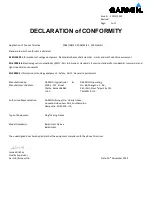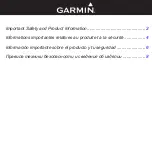
18
4.8
AUTHORIZED
REPAIR
SERVICE .............................................................. 15
4.9
CONTACT
INFORMATION...................................................................... 15
SECTION 5: SPECIFICATIONS AND SAFETY ................................................... 16
5.1
SPECIFICATIONS.................................................................................... 16
5.2
MODE
OF
OPERATION .......................................................................... 17
5.3
PHYSICAL
DIMENSIONS......................................................................... 17
5.4
ENVIRONMENTAL
REQUIREMENTS ...................................................... 17
OPERATING CONDITIONS..................................................................... 17
STORAGE AND SHIPPING CONDITIONS................................................
SECTION 6: ACCESSORIES............................................................................ 18
6.1
OVERVIEW ............................................................................................ 18
6.2
PRODUCT
ACCESSORIES........................................................................ 18
APPENDIX A: EMC INFORMATION-GUIDANCE AND MANUFACTURE
’
S
DECLARATION ............................................................................................ 19
21
electromagnetic site survey, should
be less than the compliance level in
each frequency range.
b. Interference may occur in the
vicinity of equipment marked with
the following symbol:
NOTE 1 At 80 MHz and 800 MHz, the higher frequency range applies.
NOTE 2 These guidelines may not apply in all situations. Electromagnetic
propagation is affected by absorption and reflection from structures,
objects and people.
a. Field strengths from fixed transmitters, such as base stations for radio
(cellular/cordless) telephones and land mobile radios, amateur radio, AM
and FM radio broadcast and TV broadcast cannot be predicted
theoretically with accuracy. To assess the electromagnetic environment
due to fixed RF transmitters, an electromagnetic site survey should be
considered. If the measured field strength in the location in which the
Fetal Heart Detector
is used exceeds the applicable RF compliance level
above, the
Fetal Heart Detector
should be observed to verify normal
operation. If abnormal performance is observed, additional measures may
be necessary, such as re-orienting or relocating the
Fetal Heart Detector
.
b Over the frequency range 150 kHz to 80 MHz, field strengths should be
less than 3 V/m.
Recommended separation distances between portable and mobile RF
communications equipment and the
Fetal Heart Detector.
The
Fetal Heart Detector
is intended for use in an electromagnetic
environment in which radiated RF disturbances are controlled. The
customer or the user of the
Fetal Heart Detector
can help prevent
electromagnetic interference by maintaining a minimum distance
between portable and mobile RF communications equipment
(transmitters) and the
Fetal Heart Detector
as recommended below,
according to the maximum output power of the communications
equipment.
Rated
maximum
Separation distance according to frequency of transmitter
m
































